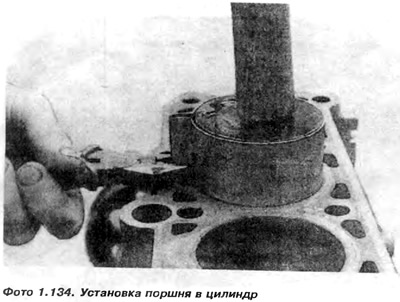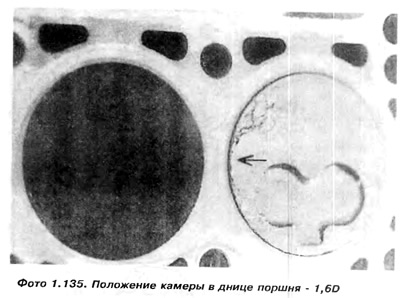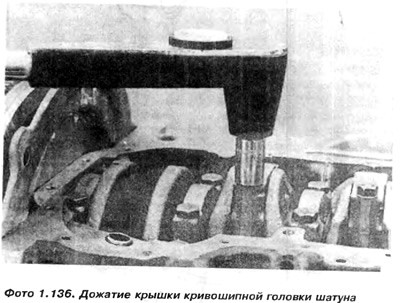1. Manufacturers recommend replacing connecting rod bolts.
2. Using belts for compression of piston rings covered with oil, we drive in pistons (lightly tapping on the bottom with the handle of a hammer) (photo 1.134). Pistons with connecting rods are inserted into the corresponding cylinders. It is necessary to do this carefully so that the belt is constantly pressed against the block. Otherwise, you can break the rings.

The crankshaft trunnion should be in the lower position - this will make it easier to install the connecting rod. The piston with the connecting rod must be installed in the cylinder in the same way as it will work in it. After installation, the piston must not be rotated, because then the locks of the rings set at 120°can move. Remember that the arrow on the bottom of the piston must point towards the distribution belt. In a 1.6D engine, the piston must be installed with a chamber in the bottom of the piston on the side of the intermediate shaft (photo 1.135).

3. Wipe the back of the liners and the sockets of the liners in the connecting rods and connecting rod caps
4. Insert the liners into the sockets of the connecting rods and caps in their own places and generously cover with oil. The tongues should go into place in the sockets.
5. We install the cover of the crank head of the connecting rod according to the preliminary designations and tighten it with a moment. specified in "Technical Data",
6. We check whether the crankshaft rotates freely with a feeler gauge, and whether the connecting rod clearance is 0.37 mm.
7. After mounting the connecting rods in the first and fourth cylinders, rotate the shaft half a turn and repeat the operations for the second and third cylinders.
8. If the engine is installed in a car, we fix the oil pump suction pipe and the oil pump suction screen, oil sump and cylinder head.


Visitor comments